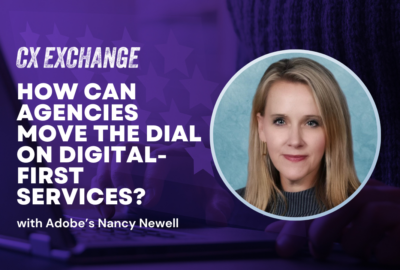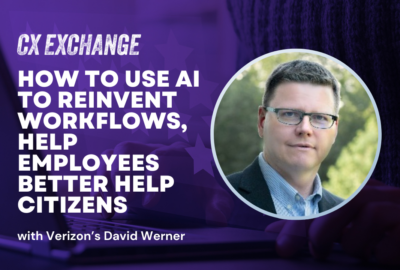CX Exchange 2024: AmeriCorps, NTSB on using TMF funding to reimagine systems and services
NTSB’s Michael Anthony and AmeriCorps’ Andrea Gibbons and Linda Southcott detail their TMF-funded efforts to improve digital services.
It might seem like agencies designated as high impact service providers receive the bulk of the attention when it comes to customer experience efforts in government, but small component and independent agencies also are pursuing transformative CX — some using Technology Modernization Fund dollars.
Two cases in point: AmeriCorps, which fosters volunteerism in service of others, and the National Transportation Safety Board, which investigates civil aviation and other U.S. transportation accidents. We talked with technology leaders from both agencies for a panel during Federal News Network’s CX Exchange 2024.
NTSB Chief Information Officer Michael Anthony noted a CX theme that many agencies encounter, namely, the importance of a broad definition of “customer.”
For NTSB, everyone is a potential stakeholder or customer constituent, Anthony said. He named the traveling public, those affected by transportation accidents, the industries whose accidents the NTSB investigates, other federal agencies with which NTSB cooperates, and the agency’s own staff as possible customers.
AmeriCorps has an equally broad constituency. Chief Modernization Officer Linda Southcott said the agency thinks in terms of the thousands of its grant-receiving organizations with whom a quarter million volunteers interact directly each year.
Tapping TMF to tackle core systems revamps
Through its TMF-funded customer experience project, AmeriCorps is replacing its 20-year-old core grant management case system. The leadership team hopes to improve things for both the agency staff and the grantees, Southcott said. AmeriCorps received a $14 million TMF investment for the modernization effort.
“We’re developing a new grants management system,” she said, “trying to bring more flexibility and efficiency to our business processes and our workflows, but also increasing access to those resources for our public constituents.”
Southcott added that with the existing system, “we have challenges in meeting our business needs and also growing and scaling up as national service continues to grow.” One issue is that federal grant management standards evolve, and it had become increasingly difficult for the legacy system to inculcate what’s known as the Federal Integrated Business Framework for Grants.
AmeriCorps planners expect the new system, which is nearing completion, to better support data-driven decision-making and deliver more value from grant-related data, said Andrea Gibbons, the agency’s chief data officer. She envisions the new system helping AmeriCorps get “to a place where we can start to do more predictive analytics and to see what changes that we can make to our programs.”
The agency began the effort to modernize the grant system and its workflow in 2022. It’s now in the final phases of design and configuration.
By comparison, NTSB’s program is nascent. It launched its TMF-funded effort about six months ago, Anthony said. The goal is to solve problems stemming from the scattered nature of the agency’s data and applications.
“Our investigative data is not centrally located,” Anthony said. “And because of that, it’s not easily accessible or even exploitable for our internal and external stakeholders.” Investigators have trouble sharing data, and they often must enter the same data into multiple systems separately, he said.
The to-be state will bring all investigative data into a single, secure environment, Anthony said.
“This is really going to streamline the management of our investigative artifacts,” he said. “That’s investigative reports, supplemental documents, accident data and, probably — most importantly safety recommendations.”
The future system, he added, will incorporate a modern, intuitive search function. Anthony anticipates future data visualization capabilities and improved data sharing with stakeholders such as the Federal Aviation Administration using application programming interfaces.
“We’re also going to be doing something we haven’t done before, and that is proactive notification of when an investigation changes,” Anthony said. Customers will be able to subscribe to alerts, rather than having to keep checking the NTSB website.
The new system, moreover, will better support an enterprise case management environment for NTSB, he said. Eventually staff will also digitize past incident and investigative data.
“And that’s where I think you really see like a force multiplier,” Anthony said. “You can really run analytics, generative artificial intelligence, all those capabilities on top of that. All of these things are really going to benefit our external constituents as well as internal staff.”
TMF benefits beyond access to funding
Small agencies typically lack deep budgetary resources to take on projects like total systems modernizations, which can leave them unable to keep pace with larger agencies they cooperate with. For instance, Southcott said, AmeriCorps has struggled to keep its systems as up to date as those of agencies like the Federal Emergency Management Agency and the Centers for Disease Control and Prevention. AmeriCorps partners with both in its public health channel.
Besides the extra money, “the TMF opportunity also gave us access to technical assistance and guidance from industry experts at the TMF board,” Southcott said.
TMF funding also comes with the virtue of not being tied to the uncertainties of regular appropriations. For fiscal 2024, those are arriving in agency coffers six months into the fiscal year. Plus, Southcott added, the TMF board will negotiate repayment plans other than 100%.
For Anthony, small agency work proved a revelation after spending the bulk of his early career as an Army civilian and at the IRS, Anthony said. At NTSB, funding is relatively thinner, and people typically wear multiple hats, he said.
“The bottom line is: Our past and current appropriations simply don’t meet our internal and external customer demands,” Anthony said. “And because of this, we continue to add technical debt.” Multiple mandates pertaining to initiatives such as zero trust and artificial intelligence only compound the problem, he said.
“TMF for us is a game changer to enable us to do some of the things we know we need to do,” Anthony said. “We just haven’t had the resources to do it.”
Prioritizing CX investments
Even with extra money from TMF, technical and program managers must pick their opportunities carefully, starting with understanding what customers need most, all three panelists said.
Up-to-date case management topped the NTSB list.
“However, in our, in our case, we had to figure out what not to include,” Anthony said. “There’s a lot more demand than capacity, so we tried to select some of the most important pain points for each of our various stakeholder communities, something that we could do in a timely manner.”
At AmeriCorps, “our staff has mentioned for years, the pain points with our legacy systems,” Southcott said. Effectively going after the pain points, she said, required collaboration. That’s because one of the goals for modernization is to capture knowledge in users’ heads and express it as sharable data.
“It’s important to be doing this together with the chief data officer — having a solution that allows folks to do their jobs and do the transactions, but then building centralized data where the analytics can happen,” she said.
Added Gibbons: “We rely so heavily on institutional knowledge. We have a staff that knows everything about everything.” But they must spend a lot of time hunting for information. “That’s really what this whole effort will free people up for, to be able to use data more innovatively.”
Discover more customer experience tactics and takeaways from Federal News Network’s CX Exchange 2024 now.
Copyright © 2025 Federal News Network. All rights reserved. This website is not intended for users located within the European Economic Area.
Tom Temin is host of the Federal Drive and has been providing insight on federal technology and management issues for more than 30 years.
Follow @tteminWFED






